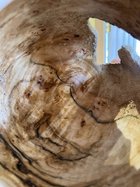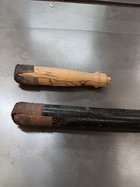I have made a couple pots, not quite hollow forms, and I need to sand the inside. One specifically is a cottonwood Burl, so it is soft and not straight grain so there are some fibers and tear out. I would’ve been fine without having to post this, I made the opening a little too large to obscure the insides and there is a void so you can see through to the inside. Unfortunately, while the opening is a little too large for my taste, I can’t fit my hand inside to sand does anybody have any ideas for how I could sand the inside, one possible idea that I have is to use a flapper wheel on a Dremel and sand the inside while it spins. Does anybody else sand the insides of their vases and if so, how do they do it if they can’t fit their hands inside?
-
We just finished moving the forums to a new hosting server. It looks like everything is functioning correctly but if you find a problem please report it in the Forum Technical Support Forum (click here) or email us at forum_moderator AT aawforum.org. Thanks! -
Beware of Counterfeit Woodturning Tools (click here for details) -
Johnathan Silwones is starting a new AAW chapter, Southern Alleghenies Woodturners, in Johnstown, PA. (click here for details) -
Congratulations to Peter Jacobson for "Red Winged Burl Bowl" being selected as Turning of the Week for April 29, 2024 (click here for details) -
Welcome new registering member. Your username must be your real First and Last name (for example: John Doe). "Screen names" and "handles" are not allowed and your registration will be deleted if you don't use your real name. Also, do not use all caps nor all lower case.
You are using an out of date browser. It may not display this or other websites correctly.
You should upgrade or use an alternative browser.
You should upgrade or use an alternative browser.
Sanding inside of vases
- Thread starter Isaac Litster
- Start date
If you use a flapper wheel in an interrupted surface, the edges of the open space will be severely rounded over. Also a flapper wheel is not meant to take away rough and ridged cuts, it's for polishing.
I use large hemostats .
I posted info on a jig I made, and still regularly use, for sanding inside hollow forms. Not sure from your picture the size or scope of what you have to sand but it might be a help for a part of it. It's in the tips and tutorial section here. I think this link will take you there
 www.aawforum.org
www.aawforum.org
Sanding inside hollow forms rig
In doing larger hollow forms the opening is large enough to see a good bit into the form. I need to do more cleanup and sanding to make it look nicer, to a point. I made this little tool recently and so far working well. It's a DeWalt 90 deg drill adapter, a 10" flex drill extender and a piece...
I use a dowel rod, 1" diameter, end rounded over and a slit cut in the end. I fold over used orbital sander sandpaper in slit and stick that in, held in my hands, no drill used. Does ok for me.
So do I, and they work great to hold a small folded-over piece of sandpaper (try a 2x2 in. square, folded over once). Here's a nice set of 6 at Amazon for cheap. 3 lengths, 3 curved, 3 straight.I use large hemostats .
https://www.amazon.com/Ultimate-Hem...id=1712893134&sprefix=hemostat,aps,134&sr=8-5
Do not, Do Not, DO NOT have your fingers in the holes when you have the sandpaper inserted in the spinning wood. If something goes wrong, they could twist hard and fast and cause serious injury to fingers. I just grasp them out around the finger holes.
john lucas
AAW Forum Expert
- Joined
- Nov 24, 2019
- Messages
- 30
- Likes
- 372
- Location
- Dresher, Pennsylvania
- Website
- www.rareearthbowls.com
Perhaps something like this scuff and buff ball:

 www.woodworkingshop.com
www.woodworkingshop.com

2" Scuff & Buff Ball Kit Green 180 Grit
Klingspor's Woodworking Shop is full line distributor of woodworking tools and supplies from respected companies like Klingspor Abrasives.
A club member had a machine shop make up an aluminum mandrel for sanding inside hollow forms with a pneumatic drill. I think he uses a wooden donut around the shaft to guide it. You can get or make a drill-driven split mandrel which is just a rod with a kerf in the end for a sandpaper strip.
The key is to not need much sanding- I should know. I would imagine cottonwood is a tough wood to cut or scrape cleanly. What sort of tool are you using on the inside of your vase? Have you tried any kind of hook tool or carbide cup cutter?
The key is to not need much sanding- I should know. I would imagine cottonwood is a tough wood to cut or scrape cleanly. What sort of tool are you using on the inside of your vase? Have you tried any kind of hook tool or carbide cup cutter?
Last edited:
I am still in high school, and I don't have a job, so I don't have a hook tool, however, I will get a carbide tool in a couple of months maybe. I used a homemade deep hollowing tool out of a steel round bar and a 3/16 hss insert from Harbor Freight, and it probably wasn't sharp. I will keep these in mind for later, I tried the Dremel with a flex shaft and it did great, but that won't work for some shapes and sizes.A club member had a machine shop make up an aluminum mandrel for sanding inside hollow forms with a pneumatic drill. I think he uses a wooden donut around the shaft to guide it. You can get or make a drill-driven split mandrel which is just a rod with a kerf in the end for a sandpaper strip.
The key is to not need much sanding- I should know. I would imagine cottonwood is a tough wood to cut or scrape cleanly. What sort of tool are you using on the inside of your vase? Have you tried any kind of hook tool or carbide cup cutter?
This looks like it would work for some applications, I have a similar polishing bit, however, I would be concerned that it would not be aggressive enough, or durable enough for intensive sanding. I used a 1 inch flapper wheel on a Dremel flex shaft and it did well, even for an old bit.Perhaps something like this scuff and buff ball:

2" Scuff & Buff Ball Kit Green 180 Grit
Klingspor's Woodworking Shop is full line distributor of woodworking tools and supplies from respected companies like Klingspor Abrasives.www.woodworkingshop.com
Isaac a cheap way to make something for your problem is dowel rod and wooden balls. Drill a hole in the ball the size of your dowel and glue in the dowel, you can then put adhesive sand paper on it and you can also grind the wooden balls to different shapes to fit the project. Another is to put hook and loop base on the ball and use hook and loop sanding pads. My general rule is to keep the hole so small prying fingers cannot tell that it is not sanded inside but when a bigger hole happens I then use the dowel and ball method
I use sanding wheels similar to these. They come in sizes that fit into any hole greater than 7/8". Sanding wheels. Made a 14" extension with a steel rod and 1/4" motor coupler. Works great in any drill. I mostly use 120, 180, and 240 grit of a different brand.
Last edited:


